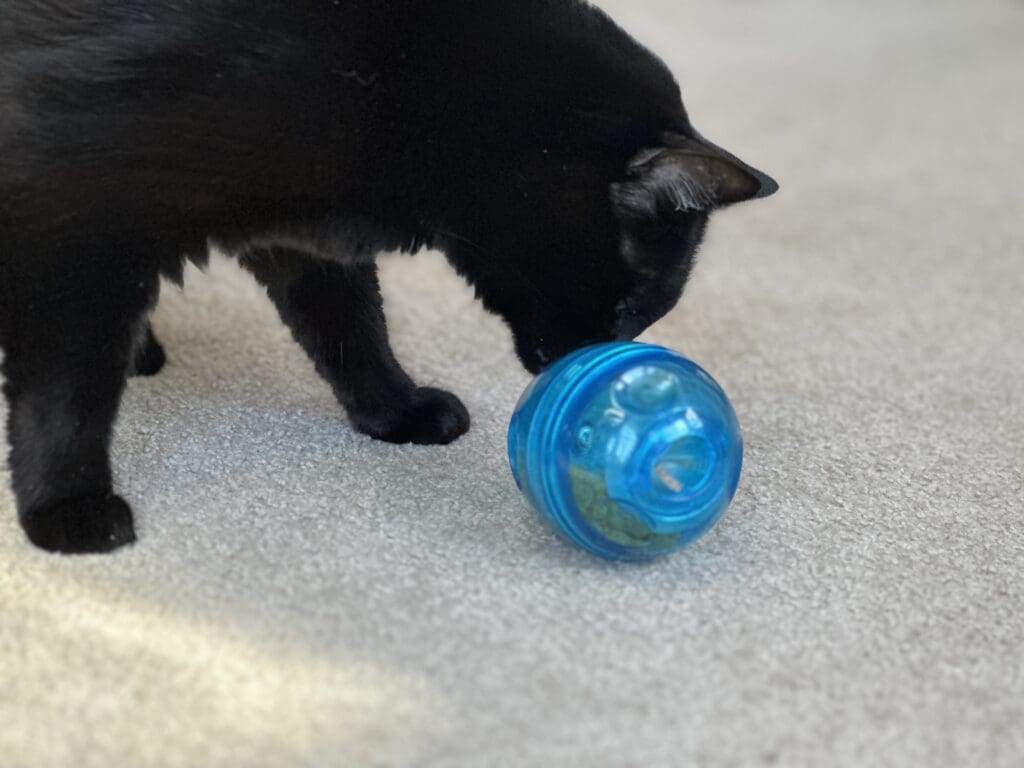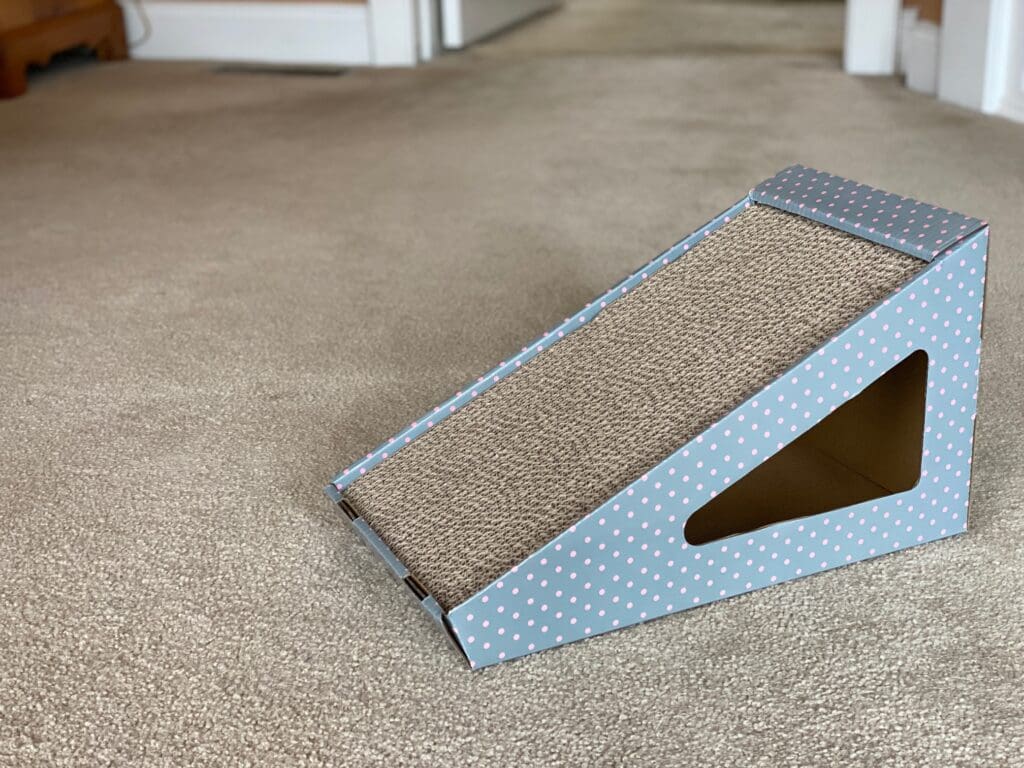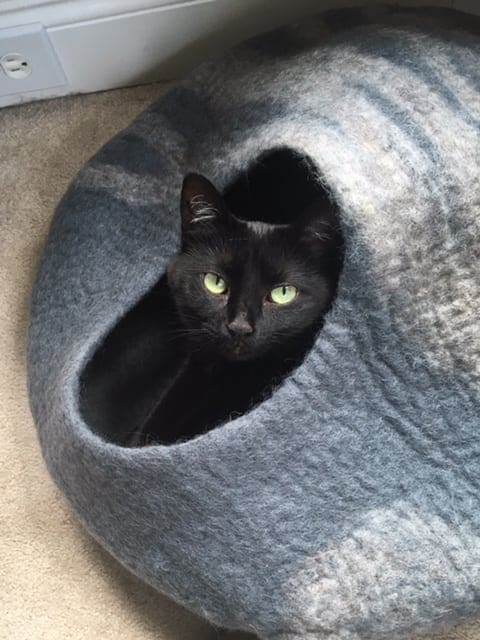
One of the things many people find very appealing about cats is that they can be left alone for longer periods than dogs. Even with the convenience of a litter box and an endless supply of food, cats left alone for long stretches of time, day after day, can suffer from loneliness, boredom, and even separation anxiety.
Indoor cats left alone with inadequate environmental enrichment are more likely to become bored or lonely. Does that mean your cat should be allowed outdoors? In my opinion, no. The outdoor environment is filled with danger and uncertainty. It’s my recommendation that cats be kept indoors but that means you have a responsibility to provide the enrichment needed to keep your cat mentally active and healthy.
Some Signs Your Cat may be Bored
- Over-eating
- Lack of appetite
- Sleeping more than normal
- Destructive behavior
- Over-grooming (even to the point of creating bald patches)
- Depression
- Litter box issues
If your cat is displaying any of the above behaviors or another change in normal behavior, the first step is to visit the veterinarian. Behavioral changes can be due to an underlying medical condition so it’s important to get a veterinary exam before assuming a problem is behavioral. If there does turn out to be a medical issue it doesn’t mean your cat won’t also benefit from some boredom busters as well though.
Trying to figure out if your cat is bored? Or curious about what he’s up to when you’re not around? Here’s a practical tip: set up a surveillance cam! You can find inexpensive cameras online that sync to your smartphone. Not only will you be keeping tabs on your home security, but you’ll also discover the secret life of your cat and whether boredom has taken hold.
Every cat benefits from environmental enrichment, customized for their age, physical ability, and emotional and mental needs. To get you started, here are some tips to help prevent boredom in your home alone cat.
1. Set out Some Puzzle Feeders
Food-dispensing toys are an easy way to provide added enrichment. Working for food is a concept that’s a natural for cats but in many households, food is just piled high in the food bowl so the cat doesn’t get the opportunity to seek out prey. As hunters, cats enjoy the chance to search for prey, stalk, pounce and enjoy their reward. Use a puzzle feeder so you can enjoy a little bonus playtime during meals. The puzzle feeder also encourages a cat to eat more slowly. There are puzzle feeders available for both dry and wet food dry food. There are more for dry food because wet food will spoil more quickly, especially if you plan on leaving puzzle feeders out for the day while you’re at work. You can still use wet food puzzle feeders but they’re best when the cat can enjoy them right away to ensure freshness.
Introduce your cat to puzzle feeders by starting with one that’s very easy so it doesn’t create frustration. It’s important to keep the experience fun for your cat.

2. Create Treasure Hunts
Hide a few treats around the house in places you know your cat typically goes and this will create opportunities for some treasure hunting. Don’t go overboard because treats shouldn’t make up more than 10% of a cat’s meal. Place a few treats around so your cat’s nose can do a little work to locate those tiny but tasty rewards.
3. Scratching Post and Scratching Pads
If you haven’t provided your cat with a scratching post it’s certainly long overdue. If the current one is gathering dust, it’s time to investigate why it might be failing. Most cats prefer sisal-covered posts and are not too keen on carpeted ones. Your cat also needs the post to be tall and sturdy so he can lean his weight against it while stretching and scratching. Remember to put the post where your cat likes to scratch. I find this is one of the most common mistakes cat parents make because they don’t like the look of the post so they place it in a forgotten corner. Look at where your cat is currently scratching for clues.
Some cats like to scratch horizontally and if that’s the case with your cat, you can purchase inexpensive horizontal scratching pads to scatter around. Some cats enjoy both horizontal and vertical scratching so keep that in mind as you plan your cat’s scratching arrangements.
Scratching is an important part of enrichment in a cat’s life so don’t under-estimate the value of having an appealing post available. Scratching is used not only for nail conditioning but also for stretching, marking, and emotional release.

4. The Right Toys Used the Right Way
You should have some toys for interactive playtime as well as toys for your cat’s solo play. Interactive toys are the ones you’ll use so you can engage in play sessions with your kitty. These are typically based on a fishing pole design. Interactive playtime is important for all cats but the ones who are left home alone all day will especially need them. Do a play session before you leave in the morning for work, and do at least one more when you return. A pre-bedtime playtime will also be beneficial if you have the time. Interactive playtime done before meals is a natural for cats since that’s how life works for them if they hunted outdoors. The stalk, pounce, capture, and then the meal.
Interactive play should be done at least twice daily for about 15 minutes each. There are many types of interactive toys available so when you go shopping, try to match the toy to your cat’s personality or play style.
When it comes to solo toys, don’t make the mistake of thinking that a filled toy basket is all that’s needed. To your cat, that’s just a mountain of lifeless prey. Add some spice to the toy collection by scattering them around the house in strategic spots that’ll catch a cat’s eye. Place a furry mouse on the cat tree with its tail dangling over, or pop a toy inside an open paper bag for your cat to uncover. You don’t have to have a large amount of toys to keep your cat happy. Rotate toys every week to re-ignite interest. Who knows what new favorite toy you cat will discover next?
5. Cats Love to Climb
Cats love being on elevated locations and they also love the process of getting there by climbing or jumping. Create safe climbing options for your cat by having a sturdy cat tree. It may seem like a costly expense but a well-made, sturdy tree should last your cat’s lifetime. Make sure the tree’s perches are large and comfortable. Typically, “u” shaped perches are best because they allow the cat to feel more secure.
Other climbing/perching options can be created by installing sturdy window perches or cat shelving. You can even create cat walkways. Just make sure everything you purchase or create is sturdy, safe and comfortable. Walkways and cat stairs should be covered in non-slip material.
When shopping for perches, shelves, and trees, pay attention to your cat’s size and any mobility issues. Make sure products are large enough to comfortably fit your cat so limbs aren’t left dangling off the edge. Also, if your cat has any limited mobility, use ramps or non-slip stairs so he can still enjoy favorite elevated locations.
6. Window Views
Cats adore heights for the same reason we love getting the best seat in the house. It’s all about the view! So, to brighten your cat’s day, why not place a cat tree by the window? Or, if you’re short on space, place a cozy bed atop a cabinet for a purr-fect perch. Oh, and let’s not forget the ultimate kitty TV: a bird feeder outside! Just be sure there’s no chance of a neighbor’s outdoor cat coming over and spoiling things.

7. Let the Sun Shine in
Most cats are all about that sun worshipping life. But why settle for just a sun ray when you can snooze in style on a cat tree or window perch? Plus, if you’ve got a room with a view, leave the curtain wide open to let the sun’s rays flood in so your kitty can nap like a king on the soft carpet. Time for some serious catnaps!
8. Places to Hide
While you’re gone during the day you have no way of knowing whether anything very noisy or frightening occurs right outside your home. Whether it’s construction, a car accident, sirens, thunderstorms or even someone knocking on your door. Provide your cat with places to hide. Very often cats will seek out a hiding place during severe storms and if you create cozy hideaways they may be a more secure option for kitty instead of ducking under the bed.
Set up a couple covered beds, cat tunnels, or even just open towel-lined boxes placed on their sides. In my house, I have open beds and hideaways available for my cat so she always has a comfortable option.

9. Have a Consistent Schedule
Cats take comfort in routine and predictability, so it’s no surprise that a lack of structure can create stress. Do your best to stick to a set schedule for meals, playtime, litter box cleaning, and other daily rituals.
10. Use Boxes and Bags
I previously talked about using boxes as cozy hideaways but also use them, as well as bags, for playtime and fun. Leave a couple boxes or paper bags out for entertainment. You can cut holes in a box and then turn it upside down to create a kitty fort or cut the bottoms out of paper bags and tape the bags together to make a homemade kitty tunnel. Cats love to explore and this is an inexpensive way to add a little extra activity into your cat’s day. If using bags, make sure they are paper and never plastic and that you cut all handles off to prevent the risk of strangulation.
I love to hide little toys in boxes and bags as an added surprise for my cat.
11. Have a Catnip Party
Set out a little dried catnip (or silvervine if your cat doesn’t react to catnip) twice a week so your cat can enjoy a little catnip party. You can just leave it loose on something like a paper plate or you can rub a couple toys with the dried leaves. I typically leave a few toys “marinating” in a container of dried catnip and then offer that to my cat.
Although catnip is safe for cats, don’t offer it more than twice a week because if constantly exposed to the herb, cats can become immune to its effects.
12. Have a Pet Sitter or Neighbor Visit
If you spend very long hours away from work or if there are a few days coming up where you know you’ll be delayed, consider having a pet sitter or trusted neighbor come in to care for your cat or offer a little mid-day playtime. Maybe there’s a teenager in the neighborhood who would like to earn a little extra money by visiting your cat every afternoon. The person must be someone your cat knows and likes so the experience of having a visitor in the home doesn’t add anxiety.
13. Bring in Some of the Outdoors
There are so many interesting scents and textures outdoors and there are a few ways you can bring those indoors so your cat can enjoy them without the danger of being outside. In the Fall, bring in a few dried leaves for your cat to play with. The lightness and crunch of the leaves may make them appealing toys. Bird feathers found on the ground could be brought indoors for playtime as well (wash them first). If you don’t use any weed killers or pesticides on your grass you could snip a few blades for your cat to munch on. The other option is to get a container of kitty greens from the pet product store and grow a patch of grass indoors.
14. Maybe it’s Time to Add a Companion Cat
Adding another cat to the family can be a wonderful way to provide companionship and friendship. Introductions take time and finesse so if you think the addition of another cat would be a good idea, make sure you can devote the time needed to do a gradual and positive introduction.
15. Make the Most of Your Time Together
After a hectic day, nothing beats a little rest and relaxation. But hold on! Your cat has been yearning for your company all day long. So, when you step through that door, it’s game time for your cat. Take a breather and enjoy some play, and if your cat likes it, lap and snuggle time. Keep him engaged by chatting away as you get ready for bed, especially if he’s not a fan of physical touch. Give your kitty the quality time he deserves!
Need More Information?
For more specifics on cat behavior and training, refer to the books by best-selling author, Pam Johnson-Bennett. You can find the books at bookstores and online. We have included Amazon links here on our website.
If you have a question about your cat’s behavior or health, contact your veterinarian. This article is not intended as a medical diagnosis nor is it a replacement for your cat’s regular veterinary care. This article is for general information purposes only.




